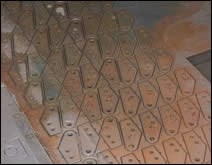Productivity Soars With Dual-Head Waterjet
When SKL Fabricators, Inc., decided to upgrade its waterjet system in 2004, the Malden, Massachusetts fabricator and machine shop selected an HR48 from Jet Edge, Inc. The high-rail gantry system is powered by a 50-horsepower 55-50C intensifier pump capable of pressurizing water to 55,000 pounds per square inch. It is controlled by the manufacturer's PC-based AquaVision interface featuring SigmaNest software.
Share




When SKL Fabricators, Inc., decided to upgrade its waterjet system in 2004, the Malden, Massachusetts fabricator and machine shop selected an HR48 from Jet Edge, Inc. (St. Michael, Minnesota). The high-rail gantry system is powered by a 50-horsepower 55-50C intensifier pump capable of pressurizing water to 55,000 pounds per square inch. It is controlled by the manufacturer’s PC-based AquaVision interface featuring SigmaNest software.
These two components have features such as Automatic Trueshape Nesting; Automatic Feedrate generation and corner ramping; graphical and/or G and M code display; plate alignment; remote pendant; real-time cutter compensation; point- and-click start/stop points; and more. Trueshape Nesting automatically positions parts to be cut from sheets, which can maximize material use and minimize cycle times. With its previous system, the company had to manually position these parts into a nest, a task that required hours of valuable production time. After implementing the system, the company reported that feedrate generation and corner ramping yielded “near perfect” edge quality, absolute minimum taper and accurate cutting tolerances—all automated.
SKL says it opted for waterjet cutting instead of laser cutting because laser cutters are limited as to the thicknesses that they can cut—effectively to 3/4 inch. Lasers struggle with materials such as aluminum, bronze, brass and other “yellow metals,” whereas the Jet Edge system excels when working with these materials. In addition, lasers cannot process rubbers or plastics, which the company uses to manufacture O-rings and gaskets.
Since upgrading to the Jet Edge system, the company has observed both gains in productivity and cost savings. When asked about the Jet Edge system versus the old system, Foreman George Wilkes, who has been with the company since 1985, said that there is no comparison. The machine that the company formerly used was not meeting production requirements, as it had lower pump pressure, a single cutting head, a cumbersome controller and labor-intensive programming software. The company has found that the new waterjet’s higher pounds per square inch is conducive to faster cutting rates, quicker cycle times, improved tolerances and less taper.
In business since 1983, SKL provides waterjet cutting and punch press services to the medical and semi-conductor industries. The company began offering waterjet services in 1995. Today, waterjet composes 40 percent of its business.
The waterjet cuts a variety of materials, including steel, stainless steel, aluminum, polycarbonate, G-10 composite and rubber. SKL operates two waterjet cutting heads on its Jet Edge system, which is capable of cutting with or without abrasive. For softer materials such as rubbers and plastics that the company uses to make parts such as gaskets and O-rings, it cuts without an abrasive. By contrast, the company uses an abrasive when machining harder materials such as steels, SS and aerospace alloys, which SKL would generally use for any custom-fabricated requirements.
The company routinely cuts parts with thicknesses ranging from 0.001 inch to 2 inches. In addition, it has used the new waterjet to successfully cut steel shims that were 0.0001 inch thick. SKL has used the waterjet to create products ranging from medical equipment to computer chassis, and even custom banisters for a wraparound porch. It recently completed a 6-week project fabricating an intricate ultrasonic cleaning system from heavy stainless steel.
According to Mr. Wilkes, the waterjet system is relatively easy to use and maintain. He also says that it is easy for him to replace the high-pressure seals on the intensifier pump. Now, Mr. Wilkes can do a high-pressure seal change in 20 minutes, a job that previously required 1 hour per side.
In addition, the new waterjet has saved time by allowing Mr. Wilkes to cut parts without the time-consuming setup of traditional machine tools. Time savings realized by SKL can also be attributed to the PC-based AquaVision controller. The controller’s capability to accept dxf, dwg, CNC files and others directly from customers reduces programming time, the company says. Because the company can now deliver prototypes more quickly, it can pass savings to its customers.
“If I don’t have the right sized tooling, or if it’s going to be a lot of work to tool, I just throw it on the jet,” he says. “It saves money on sheet metal tooling.”
In addition to the capabilities of the machine itself, Mr. Wilkes says he also has been pleased with Jet Edge’s customer service and online parts ordering system.
Read Next
5 Rules of Thumb for Buying CNC Machine Tools
Use these tips to carefully plan your machine tool purchases and to avoid regretting your decision later.
Read MoreRegistration Now Open for the Precision Machining Technology Show (PMTS) 2025
The precision machining industry’s premier event returns to Cleveland, OH, April 1-3.
Read MoreSetting Up the Building Blocks for a Digital Factory
Woodward Inc. spent over a year developing an API to connect machines to its digital factory. Caron Engineering’s MiConnect has cut most of this process while also granting the shop greater access to machine information.
Read More
































